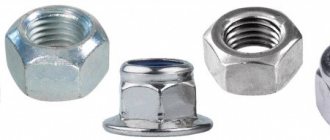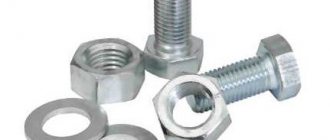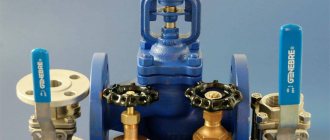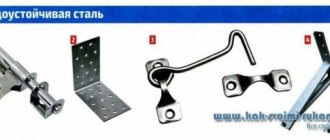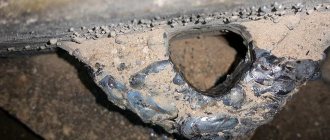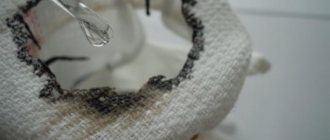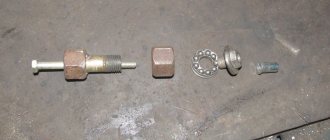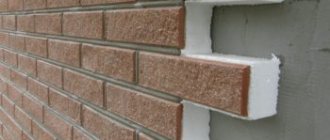From simple to complex.
The lock washer is familiar to everyone. It is used everywhere and is perhaps the most well-known remedy against spontaneous unscrewing of threaded connections.
The Grover is good because it combines the properties of a spring washer and a toothed one, and it is also cheap to produce.
But let's look at other options. After all, in addition to the locking washer, there are many other means to prevent bolts or nuts from loosening. We won’t talk about chemicals like Locktite - for now we are only interested in the simplest mechanical solutions in the form of washers and nuts.
So, there is also a spring washer that creates preload (just like the Grover itself) and prevents the nut from loosening:
A toothed washer is based on a slightly different principle. The teeth work both as springs and as spikes, biting into the material of the nut and body and preventing the nut from turning:
These three washers discussed above are more or less familiar to everyone. I think I won’t surprise anyone with a nut with a plastic ring, which is also a quite effective means of preventing self-loosening:
Nut with plastic ring
NEW SOLUTIONS
Now let's look at relatively new solutions in fixing threaded connections. Let's start with an analogue of a traditional washer with teeth.
Type 1. Fine tooth washer
The new type of washer has a fine notch on both surfaces, which, when tightened, bites into the material of the nut and the part and prevents them from rotating relative to each other:
fine tooth washers
There are also nuts with a built-in platform with similar teeth. By the way, they are quite widespread, unlike washers.
Type 2. Dispersing washers
The next option is an advanced modification of the previous washer. The system consists of two washers, the outer surface of which has a regular fine notch for biting into the material. But on the contacting surfaces, these washers have a slightly different tooth - like a ratchet. The configuration of this tooth allows the washers to scroll in only one direction - the direction of unwinding of the thread. Moreover, when you try to unwind the washers, a wedging effect occurs - both washers diverge and the outer teeth of the washers bite into the material even more strongly.
The washers must come in pairs. Between them they have a large tooth, which allows them to rotate relative to each other only in the direction of unscrewing the nut. On both outer surfaces there is a fine notch for biting into the material. The tooth angle is greater than the thread angle. This ensures a guaranteed wedging effect of the washers when trying to unscrew the connection.
Type 3. Nut with built-in riving washers
The next anti-twist solution is a nut equipped with the wedge washers discussed above:
Wheel nuts
The principle is the same, only the washers are rolled onto the nut, which is convenient, for example, when fastening car wheels. The nut is called “Wheel Nut”.
Type 4. Spring washers with wedging effect
The next modification of the same two washers with a ratchet tooth is spring washers. This, in addition to the advantages discussed above, also provides additional preload, which provides an even greater guarantee of reliable fixation of the threaded connection:
spring washers with wedging effect
Type 5. Self-deforming nut
The next modification is a specially shaped nut, which, when tightened, becomes slightly deformed, compressing the threads in its upper part and loosening slightly in the lower part.
Self-deforming nut
Deformation of this nut gives two positive effects at once. The first is in the form of relieving stress on the bolt in the area of the lower part of the nut and the second is fixing the thread in the upper part:
Tightened self-deforming nut in section
Why use thread lockers?
Thread adhesive is able to complete polymerization when there is no access to air, resulting in an ideal connection of pipe parts, for example, in a water supply system. This avoids water leakage, gas escaping, etc. It also prevents parts from unscrewing under the influence of vibration and mechanical influences.
Using thread adhesive is simple, and there are different forms of similar compounds available. This allows every master to find a convenient option for his work.
Thread adhesive is able to complete polymerization when there is no access to air, resulting in an ideal connection of pipe parts, for example, in a water supply system.
Types of Durostone® fastening joints
EPR S5/EPR S7. Chemical and marine applications; Particularly resistant to aggressive environments - heat resistance up to 180 ° C.
EPR S6
Durostone® EPR S6 is a high-pressure epoxy laminate with superior properties designed specifically for threaded rod applications.
UPR S19
Durostone® UPR S19 is a Sheet-Moulding-Compound (SMC) threaded rod made from unsaturated polyester resin and fiberglass.
- A special type of polyester meets the highest dielectric constant requirements.
- At the same time, it does not produce an internal discharge even at high electric field strengths and is highly resistant to stray currents CTI 600.
VEG-Z/VEM
Used in chemical fields with low mechanical requirements.
EPR S1/EPM 203
Standard quality for use in electrical, marine and mechanical applications; heat resistance up to 180°C.
Basic properties:
- Electrical properties. All Durostone® fasteners are electrically insulating and anti-magnetic. In addition, some models are particularly resistant to parasitic currents and operate without internal discharge up to high electric field voltages. Thus, they are excellent for use in transformers, electrical machine manufacturing, high-frequency and switching devices, and electrostatic grinding devices.
- Chemical properties. Durostone® fasteners are particularly resistant to aggressive environmental conditions. Transformer, ultraviolet radiation and atmospheric influences will not be able to cause any significant harm to it. Applications include, for example, the production of chemical equipment, cable routes, flue gas desulphurization, seawater desalination, and wastewater treatment.
- Thermal properties. Compared to steel (15–58 W/mK), all Durostone® material types have a very low thermal conductivity of 0.3 W/mK and are thus on the level of mineral wool, which is used in construction as an insulating material. They are therefore excellent for use in refrigeration and air conditioning systems and in areas where thermal bridges must be avoided.
- Lightweight design. Durostone® fasteners have a density of 1.9 to 2 g/cm³, which is approximately the density of steel. It is very well suited for applications where weight reduction is an important factor, such as in the production of automobiles or gondola cars for wind turbines.
- High strength. Compared to threaded rods made from thermoplastics such as polyamide, Durostone® threaded rods have six times the tensile strength.
Advantages and disadvantages
Thread sealant for bolts stands out for its ease of use, which is why they are often chosen. The popularity of the products is also due to the positive properties described below:
- After applying the product and drying, they do not move or shrink;
- Additional protection of the metal from rusty formations is created;
- The presence of different types of compositions facilitates their use for parts of different sizes;
- Adhesives for bolted joints prevent loss of fixation force, withstand vibration loads, as well as impact;
- Their consistency allows the composition to penetrate into the smallest crevices, providing an airtight seal.
Stop thread sealant also has disadvantages:
- Reinforced types of means do not make it possible to easily unscrew the threaded rods if necessary, then they resort to high-temperature exposure or special tools;
- When choosing, take into account the specifics of the material so that the composition does not damage its integrity;
- Adhesives dry quickly, so it is necessary to accurately apply the layer; it will be impossible to change the position of the bolts, and it is impossible to return the composition to a liquid state;
- You should not use adhesives at low temperatures, this affects how long the layer will take to dry, the period will become longer.
Thread sealant for bolts stands out for its ease of use, which is why they are often chosen.
Composition of thread locker
The instructions for each product specify the components used in production. Each type will include different components, so you should carefully study the composition before purchasing. The level of connection depends on the composition, and determines the resulting properties.
The level of connection depends on the composition, and determines the resulting properties.
How to Choose the Best Thread Locker
To get a high-quality result, you need to choose the right composition for the task. In this case, the criteria that influence the result are determined. Experts advise paying attention to: fixed moment of resistance, state of aggregation, resistance to process fluids, polymerization time.
To get a high-quality result, you need to choose the right composition for the task.
Fixed moment of resistance
This parameter helps you understand what size bolt the product will be suitable for. If the composition is intended for small bolts, then it will not be possible to obtain reliable fixation of large ones. Conversely, when small bolts are attached to reinforced clamps, then unscrewing them may become impossible. But manufacturers do not always specify this parameter.
This parameter helps you understand what size bolt the product will be suitable for.
State of aggregation
There are paste and liquid thread lockers. The first option is not so convenient to use, but they will not spread to unnecessary areas. Liquid types are standard for hard-to-reach bolts, but may bleed.
When choosing, take into account the size of the thread; the larger it is, the harder the option should be chosen for gluing.
When choosing, take into account the size of the thread; the larger it is, the harder the option should be chosen for gluing.
Resistant to process fluids
When operation involves exposure to different liquids, then when choosing a composition, you need to pay attention to indicating whether the layer can withstand this influence. If there are no such requirements, then you can choose any composition.
When operation involves exposure to different liquids, then when choosing a composition, you need to pay attention to indicating whether the layer can withstand this influence.
Polymerization time
The drying time for adhesives varies; they begin to perform their function only after the drying stage is completed. Manufacturers write how long it takes for complete polymerization. For urgent repairs, this parameter will be important.
The drying time for adhesives varies; they begin to perform their function only after the drying stage is completed.
Value for money
One of the most important parameters is obtaining good quality at an affordable price. Here it is better to focus on popular brands that have proven themselves as high-quality adhesives. They will be discussed in detail below.
One of the most important parameters is obtaining good quality at an affordable price.
Areas of application
Anaerobic sealant is used in metal gaps when installing fittings or when gluing flat parts for the purpose of:
- preventing spontaneous loosening of threaded connections - increases resistance to vibration and shock loads;
- sealing defects in welding seams or castings, as it completely fills the space;
- sealing and fixing flange and cylindrical connections - increases the shear and deformation strength of products without creating metal stress.
To seal plastic joints, a type of anaerobic substance with a high concentration of special activators is used - isopropyl alcohol, copper salts or fluoroplastic.
How to work with thread glue
When using a retainer, it is distributed over the area where the nut should be, a thin layer is made, optimally up to 5 millimeters thick. When the parts begin to tighten, the glue will spread over the entire surface, ensuring reliable fixation.
When working with blind cracks, the product is applied to the bottom and not to the threaded area. It is recommended to clean and dry the part in advance. Also, better adhesion is achieved by treating the metal surface with a special brush.
When using a retainer, it is distributed over the area where the nut should be, a thin layer is made, optimally up to 5 millimeters thick.
How to Unscrew a Thread Locker
An option for unscrewing bolts that were locked using clamps is temperature exposure. For different fixation levels you will need different temperatures: for red – 200-250 degrees; for blue – 100 degrees; the green type can unscrew at lower temperatures. The heating tool is a soldering iron or a hair dryer.
An option for unscrewing bolts that were locked using clamps is temperature exposure.
Thread adhesives provide a high level of thread bonding and can withstand varying degrees of stress. When choosing, take into account the operating conditions in order to use a type of product that is sufficient in terms of adhesion force.
Automotive
Car seals have long outgrown conventional repair products. Currently, such sealants are used for many jobs that are performed when assembling a car at the factory. Often, with the help of such a mass, the fit of car gaskets is strengthened, and sometimes it is even used instead of a gasket. Nowadays it is very difficult to imagine repairing any auto-moto equipment without the use of sealants.
The main thing is to make sure that it is of high quality before use. Otherwise, you may stumble upon a material that will not hold oil or other liquid. If this happens, the work will have to be done again. Therefore, it is important to use only high-quality masses that are produced by trusted companies.

